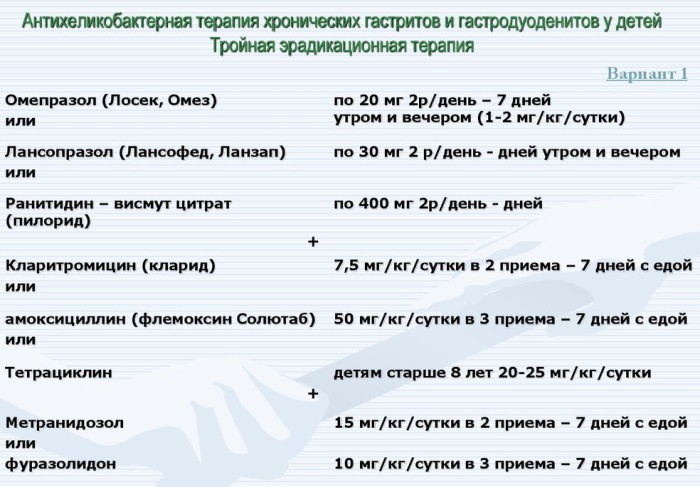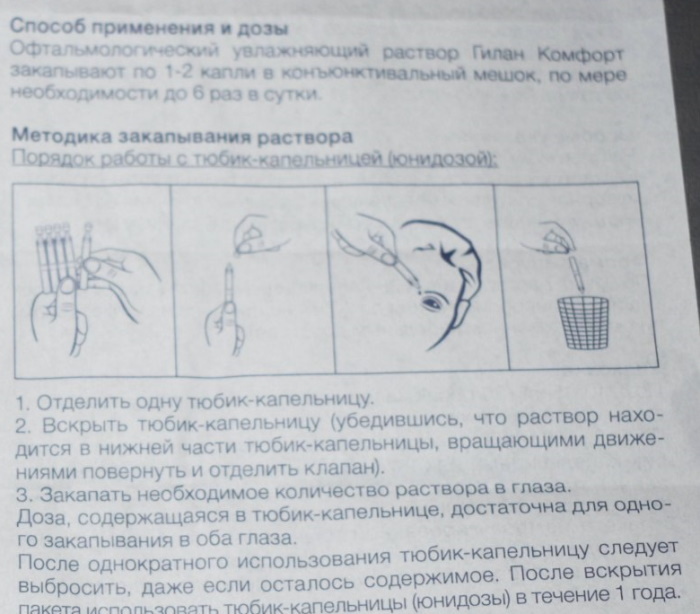Content
- Trauma classification
- Partial tendon rupture
- Subtotal gap
- Complete break
- Symptoms and Signs
- Causes
- Medicines and remedies
- Diclofenac
- Nimesulide
- Ksefokam
- Fastum
- Nimid gel
- Traditional medicine recipes
- Cold compress
- Applying a scarf bandage
- Cabbage leaf compress
- Other methods
- Surgery
- Supraspinatus Tendon Rupture Video
Supraspinatus tendon rupture - This is a severe injury to the shoulder joint that interferes with the rotational movement of the upper limb, causes an attack of acute pain, and also limits the general mobility of the musculoskeletal system sick.
Therapy for this pathology is carried out using anti-inflammatory drugs and potent pain relievers. Complicated rupture of the connective tissue of the supraspinatus muscle is treated with a surgical operation to restore the integrity of the destroyed tendon.
Trauma classification
The human shoulder joint is characterized by a complex anatomical structure. This part of the musculoskeletal system consists of the glenoid cavity, bony processes of the clavicle and scapula, and a spherical head.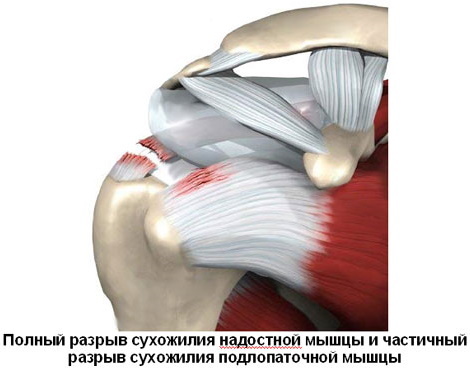
A ruptured supraspinatus tendon causes dysfunction of the rotator cuff on the right or left side of the shoulder girdle. Trauma is classified according to the severity of connective tissue damage.
Partial tendon rupture
This type of pathology differs in that as a result of an inflammatory-degenerative process or injury to the musculoskeletal system destruction of several connective fibers of the tendon occurs, but the general physiological structure of the connective tissue does not is violated.
Subtotal gap
Supraspinatus tendon injury with subtotal rupture is a more severe type of pathology in which at least 50% of connective tissue fibers show signs of destruction. The anatomical structure of this element of the musculoskeletal system is disturbed.
Complete break
Total damage to the supraspinatus tendon affects all connective tissue fibers with complete separation from the connecting parts of the shoulder joint.  This type of injury is considered the most difficult for the victim, since the treatment of pathology requires a surgical operation with further undergoing a long course of rehabilitation.
This type of injury is considered the most difficult for the victim, since the treatment of pathology requires a surgical operation with further undergoing a long course of rehabilitation.
Symptoms and Signs
A rupture of the tendon of the supraspinatus muscle of the shoulder joint is manifested by the following symptoms:
- acute pain in the region of the tubercle of the humerus, which sharply increases at the moment when the patient tries to raise his arm up or take it to the side;
- the appearance of swelling of the soft tissues of the shoulder;
- change in local body temperature upward (this symptom is determined by palpation of the injured area of the body);
- limitation of functional mobility of the upper limb in the shoulder joint;
- increasing swelling of soft tissues.
The saturation of the above symptoms depends on the type of traumatic injury to the supraspinatus muscle, as well as the anatomical state of its connective tissue. The detection of these signs occurs at the initial stage of the patient's diagnosis.
Causes
Violation of the integrity of the supraspinatus tendon can be caused by one or several reasons at once. The table below lists the main factors, the impact of which leads to the pathological condition of this part of the shoulder joint.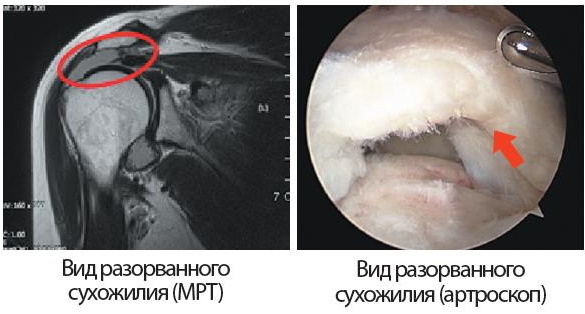
| Causes of the supraspinatus tendon rupture | Characteristics of the pathological process |
| Acute trauma | In this case, complete or partial separation of the connective tissue from the skeletal muscles occurs as a result of falling onto the upper limb, which was in an extended position, but was sharply pulled back due to contact with a hard surface of the ground, floor or other objects. |
| Exceeding the permissible load | Supraspinatus tendon rupture occurs when a person creates repeated physical stress on the shoulder joint by raising the arm up. This reason for the detachment of connective tissue is common among athletes involved in weightlifting, volleyball, mixed martial arts. In this case, the tendon rupture is preceded by an increasing inflammation of the tissue fibers, which stratify due to a chronic destructive process. |
| Degenerative-dystrophic processes | This reason for the rupture of the supraspinatus tendon is associated with age-related changes in the structure of the musculoskeletal system. Degenerative processes of the shoulder joint are found in the elderly, as well as in people suffering from osteoporosis. |
| Congenital pathology | Anomalies of intrauterine development associated with the acquisition of congenital weakness of the connective tissue of the body also cause the supraspinatus tendon to tear. |
| Acute or chronic inflammation | The defeat of the connective tissue of the shoulder girdle as a result of the inflammatory process leads to partial or complete destruction of the fibers of the supraspinatus tendon. The nature of the pathology may be associated with infection of the internal structure of the joint with infectious microorganisms, an autoimmune reaction, a previous trauma or surgery. |
A ruptured tendon of the supraspinatus muscle of the shoulder joint is an injury that requires immediate treatment. Otherwise, further destruction of connective tissue fibers will occur with the spread of the inflammatory process to adjacent areas of the musculoskeletal system.
Medicines and remedies
Partial tendon ruptures caused by trauma, acute or chronic inflammation of the shoulder joint are treated with conservative therapy. These are drugs with anti-inflammatory, analgesic and regenerating properties. A prerequisite for the use of medicines is the preservation of the anatomical structure of the connective tissue and the absence of indications for surgery.
Diclofenac
Diclofenac is a drug that belongs to the pharmacological group of anti-inflammatory nonsteroidal drugs. This medication is available in the form of rectal suppositories, capsules, liquid solution. It is used as the main or auxiliary therapy, depending on the general condition of the patient.
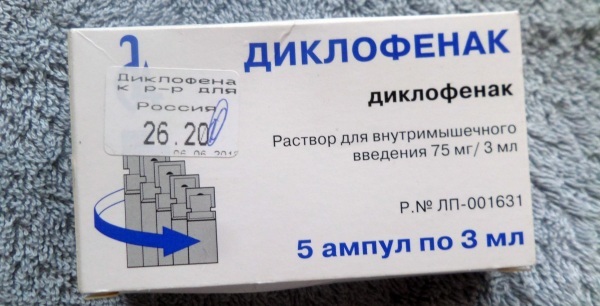
For conservative treatment of supraspinatus tendon rupture, it is advisable to use Diclofenac in the form liquid solution for intramuscular injection with a dosage of 25 mg of the active substance diclofenac sodium per 1 ml drug.
Diclofenac has the following therapeutic properties:
- relieves an attack of acute or aching pain in the shoulder;
- exhibits anti-inflammatory effect;
- helps to eliminate swelling of soft tissues;
- has an antipyretic effect.
Diclofenac in the form of injection for intramuscular administration involves the use of a single dose of 75 mg. The injection is made deep into the tissue of the gluteus muscle. Re-introduction of this medication is possible no earlier than 12 hours after the previous injection. Otherwise, the risk of side effects and overdose symptoms increases.
The duration of injection therapy with Diclofenac is 2 days. Then it is recommended to continue treatment with the same medication, but using its release form in the form of tablets or rectal suppositories. Further dosage of the anti-inflammatory agent is determined by the doctor based on the effect of the use of intramuscular injections.
Treatment with Diclofenac has the following contraindications:
- individual intolerance to acetylsalicylic acid and other non-steroidal anti-inflammatory drugs;
- proctitis;
- ulcerative lesions of the gastric mucosa;
- Crohn's disease;
- the state of pregnancy and lactation of a newborn baby by breastfeeding;
- the patient is under 18 years of age.
Diclofenac is prescribed with extreme caution to patients suffering from severe disorders in the functioning of the kidneys and liver tissues, arterial hypertension, diabetes mellitus, as well as elderly patients whose body is in a weakened condition.
During the therapy of rupture of the supraspinatus tendon with Diclofenac, the following side effects may occur:
- nausea;
- discharge of vomit;
- diarrhea;
- loss of appetite;
- anorexia;
- pancreatitis;
- hepatitis with fulminant development;
- liver failure;
- progressive stomach ulcer;
- stomatitis;
- damage to the walls of the esophagus;
- allergic reactions;
- headache;
- nausea;
- noise in ears;
- insomnia.
The average cost of Diclofenac injection solution is from 41 to 43 rubles. for 5 ampoules with a capacity of 3 ml.
Nimesulide
Nimesulide is a selective COX-2 inhibitor, which belongs to the category of anti-inflammatory nonsteroidal drugs. This drug is available in the form of a white powder, packaged in polyethylene bags with a mass fraction of the active substance nimesulide - 100 mg. This drug exhibits analgesic and anti-inflammatory properties, alleviates the pathological symptoms of a patient with signs of a partial rupture of the supraspinatus tendon.

The procedure for using Nimesulide powder is as follows:
- Pour the contents of 1 sachet into a clean cup or glass.
- Fill the container with 80-100 ml of water at room temperature.
- Crushes the medicine until the powder particles are completely dissolved.
- Drink the prepared solution.
Children over 12 years old, as well as patients of the adult age group, take the specified amount of medication 2 times a day (morning and evening). The maximum duration of a therapeutic course is 15 days.
Treatment with Nimesulide has the following contraindications:
- ulcerative lesion of the digestive tract;
- internal bleeding;
- diseases associated with blood clotting disorders;
- liver and kidney pathology;
- chronic alcoholism and drug addiction;
- the state of pregnancy;
- individual intolerance to nimesulide;
- the period of lactation of the newborn by breastfeeding.
Nimesulide is contraindicated in children under 12 years of age. This drug is prescribed with caution to patients with diabetes mellitus, severe diseases of the arterial vessels. Nimesulide is dispensed by prescription, and its average cost is 219 rubles. for 30 sachets.
Ksefokam
Ksefokam is a drug belonging to the pharmacological group of anti-inflammatory nonsteroidal drugs, which is produced in the form of a yellow lyophilisate. On the basis of this medication, a clear solution is prepared for intramuscular and intravenous administration.
Ksefokam was created for the symptomatic treatment of diseases of the musculoskeletal system, which have an inflammatory or traumatic etiology. The active substance of this medication is lornoxicam at a dosage of 8 mg in 1 bottle.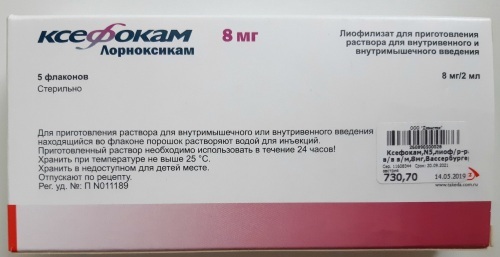
To use the drug Ksefokam, the following algorithm of actions must be observed:
- Add sterile water for injection (2 ml) to the vial with the lyophilisate (8 mg).
- Beat the vial with the medicine to completely dissolve the dense particles.
- Inject the prepared solution into the gluteus muscle.
In the case of intravenous administration of this medication, the injection of the solution into the patient's circulatory system should continue for at least 15 seconds, and with intramuscular injection - 5 seconds. A single dose of Xefocam is 5 mg. The maximum daily dosage with this drug should not exceed 16 mg of the active substance.
Xefocam therapy has the following contraindications:
- rehabilitation period after coronary artery bypass grafting;
- recurrent sinus polyposis;
- hemorrhagic diathesis;
- ulcerative lesion of the digestive tract;
- internal bleeding;
- renal failure;
- the state of pregnancy;
- peptic ulcer;
- lactation of a newborn with breast milk;
- an allergic reaction to drugs from the group of non-steroidal anti-inflammatory drugs.
The sale of the drug Ksefokam is carried out on the basis of a prescription from the attending physician. The average cost of this medication is from 610 to 624 rubles. for 5 vials filled with 8 mg of lyophilisate.
Fastum
A rupture of the tendon of the supraspinatus muscle of the shoulder joint without disturbing the anatomical structure of the connective tissue is treated with the use of external anti-inflammatory drugs.
The drug Fastum is produced in the form of a transparent gel with a pleasant odor. The active substance of this medication is ketoprofen at a concentration of 2.4 g per 100 g of the finished product. Fastum has anti-inflammatory and analgesic effects, accelerating the regeneration of injured tendon fibers.
Fastum gel is applied to the skin surface of the injured shoulder 2-3 times a day. The drug is evenly distributed over the epithelial tissues, under which the pain syndrome is localized. The duration of the treatment course is no more than 14 days. The therapeutic effectiveness of this agent is enhanced in the case of the simultaneous use of injectable anti-inflammatory drugs.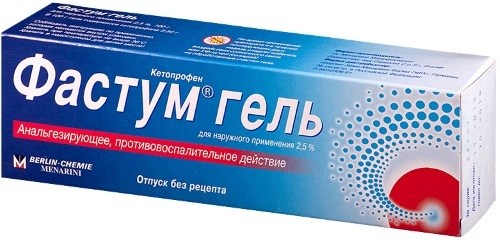
Treatment with Fastum is contraindicated in the following cases:
- individual intolerance to medications based on ketoprofen;
- violation of the integrity of the skin in the area of application of the gel;
- history of bronchial asthma;
- children under 15 years of age;
- 3rd trimester of pregnancy.
Fastum gel is prescribed with caution to patients with gastrointestinal ulcers, severe liver and kidney pathologies, heart failure. This medication is dispensed without a doctor's prescription, and its average cost is 238 rubles. for 1 tube with a capacity of 30 g.
Nimid gel
The drug Nimid gel is an anti-inflammatory, non-steroidal drug that promotes faster healing of the damaged tendon of the shoulder joint. This medication relieves swelling of injured tissues, has an anesthetic effect. The active substance of Nimid gel is nimesulide at a concentration of 10 mg per 1 g of the finished product. In terms of therapeutic effect, this component is not inferior to indomethacin and piroxicam.
Nimid gel is applied to the surface of the diseased shoulder joint 3 to 4 times a day. Before starting the therapeutic procedure, the skin in the area of localization of the pain syndrome must be thoroughly washed with warm water and soap, and then wiped off with a clean dry towel.
The gel is spread in a thin layer over the entire surface of the injured shoulder. After drug treatment of epithelial tissues, it is necessary to wait 5-10 minutes. until the drug is completely absorbed. The duration of the therapeutic course with Nimid gel is 4 weeks.
This drug has the following contraindications:
- allergy to nimesulide;
- skin diseases of an infectious nature;
- the presence of open wounds in the area of application of the gel;
- dermatitis.

During the use of Nimid gel, side effects may occur in the form of reddening of the skin of the sore shoulder with various signs of an allergic reaction. The average cost of this tool is 312 rubles.
Traditional medicine recipes
The use of traditional medicine recipes is advisable only if the patient is diagnosed with partial tear of the supraspinatus tendon without violating its overall integrity and anatomical structures.
Cold compress
The application of a cold compress is effective in the first 5-10 minutes. after injury to the shoulder joint. This method allows you to reduce the severity of the inflammatory process, reduce tissue swelling.
In this case, you will need to perform the following sequence of actions:
- Moisten a clean piece of cloth under a stream of cold water.
- Apply a compress to the surface of the injured shoulder.
- Keep a cold cloth on the body for 15 minutes.
You can also use ice as a source of cold, which is wrapped in a bag or cloth.
Applying a scarf bandage
Fixation of a sick upper limb with a kerchief bandage makes it possible to immobilize the shoulder joint during the recovery of the injured tendon.
To perform this therapeutic procedure, the following rules must be observed:
- Take a bath towel or a piece of thick cloth at least 30 cm wide and 1.5 m long.
- The edges of the fabric cut are tied together with a strong knot.
- The bandage is put on the neck, and in its inner part, like a hammock, is placed a hand, the shoulder joint of which is damaged.

The upper limb should be half bent at the elbow. The therapeutic effectiveness of this folk remedy is enhanced in the case of the simultaneous use of conservative treatment. The average duration of wearing this bandage is 1 month.
Cabbage leaf compress
The cabbage leaf is believed to have anti-inflammatory properties, relieve pain and relieve swelling.
The application of this compress is as follows:
- A washed, medium-sized cabbage leaf is laid on the surface of the diseased joint.
- A fixation bandage is applied on top of the injured area of the shoulder.
- The cabbage leaf is on the surface of the patient's body for at least 12 hours.
This therapy is best done at night. The duration of treatment is from 10 to 15 days. For the next compress, you need to prepare a fresh cabbage leaf.
Other methods
A rupture of the tendon of the supraspinatus muscle of the shoulder joint with complete or subtotal damage to the connective tissue is repaired by surgery.
Surgery
The operation to restore the torn supraspinatus tendon is performed under the influence of general anesthesia.
The surgeon performs the following manipulations in relation to the patient aimed at restoring the motor cuff of his shoulder joint:
- An incision is made in the epithelial and soft tissues to open access to the damaged fibers of the connective tissue.
- The severed tendon is pulled to its anatomical location using surgical instruments.
- Connective tissue is sutured to the supraspinatus muscles.
- Non-viable, as well as degeneratively altered tissues formed as a result of trauma or inflammation are removed.
- Suture material is applied to the wound surface of the shoulder joint.
During the surgical attachment of the severed tendon to the tissues of the supraspinatus muscle, anchor clamps are used to increase the strength of the connective fibers. After surgery, the patient is transferred to the general therapy ward to receive further symptomatic treatment. The cost of this operation is from 70 to 140 thousand. rub. depending on the complexity of the pathology.
Supraspinatus tendon rupture is a critical condition of the shoulder joint, which is accompanied by bouts of severe pain and functional limitations of the upper limb. This pathology has a congenital, traumatic or inflammatory-degenerative nature of origin.
Treatment of detachment of connective tissue is carried out using drugs, folk remedies and surgery. Conservative therapy involves the use of medications with anti-inflammatory and analgesic properties. Surgery is indicated for patients with complete or subtotal supraspinatus tendon tear.
Supraspinatus Tendon Rupture Video
Partial rupture of the supraspinatus tendon:

